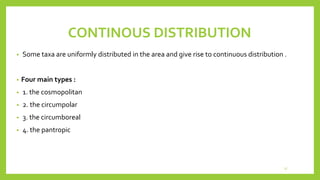The document provides an overview of phytogeography, focusing on the geographic distribution of plant species and the factors influencing it, including climate, migration, and ecological interactions. It distinguishes between ecological and historical phytogeography, and discusses various distribution types such as continuous, endemic, and discontinuous species. The document also outlines key principles governing plant distribution and references historical theories explaining these patterns.




































